PRP for Hair Loss Treatment

Platelet Rich Plasma (PRP) therapy has emerged as a groundbreaking approach in the realm of hair restoration, targeting the very essence of hair growth at the follicular level. This treatment leverages the body's own natural healing properties, harnessing the power of growth factors found in our platelet rich plasma to stimulate hair regrowth.
Whether it's battling conditions like male pattern baldness, female pattern hair loss, or androgenetic alopecia, PRP presents a promising avenue.
What is PRP Hair Treatment?
Platelet Rich Plasma (PRP) therapy is one of the most innovative and promising treatments in the field of hair restoration. A non-surgical therapeutic option, it primarily aims at stimulating hair growth for patients suffering from hair loss.
Origins of PRP Treatment
The concept of using platelet rich plasma for hair restoration isn't entirely new. PRP has been used in various medical fields, from wound healing to orthopedic surgeries, for several decades.
The application of PRP therapy in hair loss treatment began as clinicians recognized the role of growth factors in wound healing and how these could potentially be leveraged to treat thinning hair and stimulate hair regrowth.
While it's hard to attribute the development of PRP treatment for hair loss to a single pioneer, the technique has evolved over the years with numerous dermatologists and trichologists contributing to its advancement.
The rise in its popularity can largely be attributed to the tangible results many patients experienced, combined with the minimally invasive nature of the treatment.
Trichologists' Perspective
Trichologists, the experts in hair and scalp issues, view PRP therapy favorably. Given the myriad of treatment options available, including hair transplants, the non-invasive nature of PRP, combined with the fact it uses the patient's own blood, makes it an attractive proposition. However, trichologists also emphasize the need for maintenance treatments to sustain and boost the results of PRP.
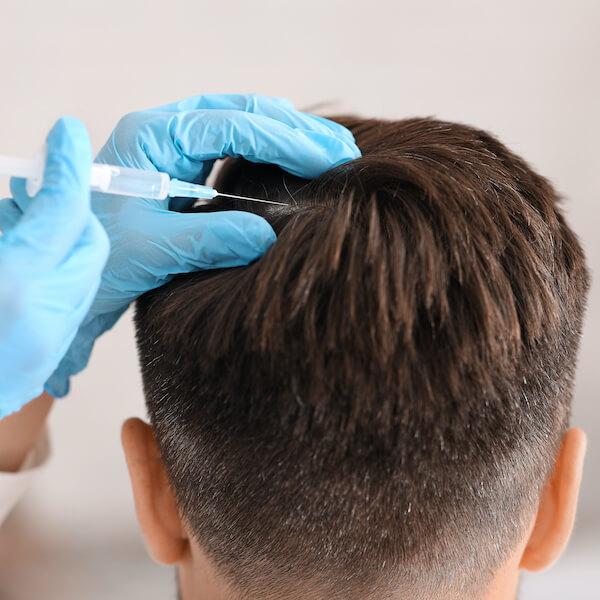
Research published in the Cureus Journal of Medical Science in 2022 looked at the experience of 56 male and female patients with PRP treatment for hair growth. The patients were all aged 20 to 68 years old with a 57/43 male to female ratio and the study found that patients were on average 80% likely to recommend PRP treatments to friends, with 64% reporting improvement in hair density.
Another study published in the Institute for International Trichology looked at the improvements after 1 year of hair transplant patients. They treated one 2.5 square centimeters of transplanted hair in each of 23 patients with PRP and left one 2.5 square centimeters as a control, finding a 15.7% increase in hair follicle density in the treated area when compared against the control.
While hair transplantation remains a popular option for those seeking a permanent solution, the growth and advancement of PRP treatments can't be overlooked. It is not just a treatment; for many, it’s a rejuvenating experience, breathing life into dormant hair follicles and promoting denser, healthier hair growth.
ENQUIRE ONLINE
Using this form to enquire online, this is the fastest way to ensure your enquiry reaches the best person in our team as quickly as possible.
The Hair Growth Process
The hair growth process is intricate and regulated by various molecular and cellular mechanisms. Understanding this process can offer valuable insights into the challenges of hair loss and the potential of treatments like platelet rich plasma (PRP) therapy.
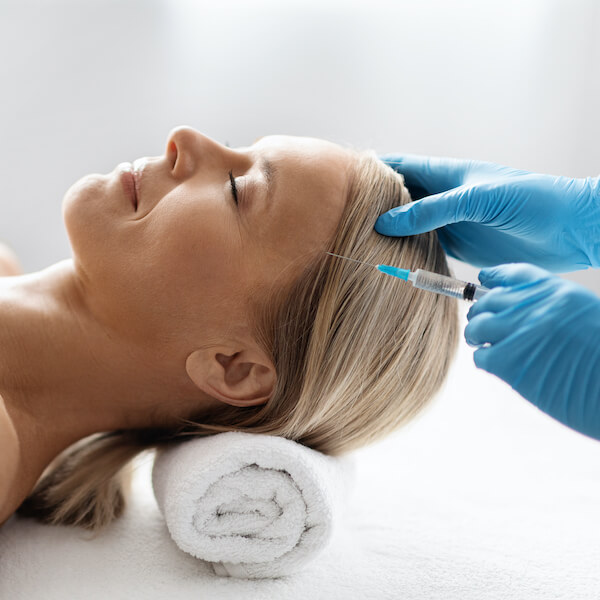
How Hair Follicles Grow
The hair growth process represents an intricate interplay of cellular activities and hormonal influences, is universally categorized into three primary phases: Anagen, Catagen, and Telogen.
Each of these stages has unique characteristics, durations, and biological functions, ensuring the continuous and cyclical nature of hair growth throughout our lives.
Anagen (Growth Phase)
The anagen phase is the active growth phase of hair follicles, and it's where the magic truly begins. Lasting anywhere between 2 to 7 years, this phase determines the ultimate length of hair.
The duration of the anagen phase is largely genetically predetermined, but external factors like nutrition, health, and hormonal balance can also influence it.
During the anagen phase, hair cells in the bulb of the follicle divide rapidly, receiving nourishment from the blood supply in the scalp.
As these cells push upwards through the follicle, they harden and undergo a process called keratinization, transforming into the hair we see and style.
It's worth noting that at any given time, about 85% to 90% of the hairs on the human head are in the anagen phase, emphasizing its pivotal role in maintaining hair density and overall health.
Catagen (Transitional Phase)
Following the active growth of the anagen phase, hair enters the catagen phase—a brief transitional period that lasts around 2 to 3 weeks.
During this phase, the hair follicle reduces in size as it detaches itself from the blood supply. This detachment results in the cessation of hair growth, transitioning the hair into a sort of "pre-resting" state.
The biological rationale behind this phase is still an area of ongoing research, but it's believed to be a preparatory stage for the follicle before it enters the true resting phase. Less than 1% of scalp hair is in the catagen phase at any point in time.
Telogen (Resting Phase)
The telogen or resting phase, lasting around 3 to 4 months, signifies a period of inactivity for the hair follicle.
At this stage, the hair strand is fully keratinized and doesn't grow any longer. Since the hair is not anchored deeply in the follicle during this phase, it is more susceptible to shedding.
On average, a person naturally sheds 50 to 100 telogen hairs a day. This phase serves as a kind of "recovery period," allowing the follicle to rejuvenate and prepare for a new anagen phase.
After the telogen phase concludes, the follicle reenters the anagen phase, producing a new hair strand and pushing the old one out, continuing the cyclical nature of hair growth.
How does a Platelet Rich Plasma Treatment for Hair Loss Work?
Hair loss, whether stemming from male pattern baldness, female pattern baldness, or other underlying conditions like alopecia areata, has led many individuals to seek effective hair loss treatment options. One of the contemporary treatments that has gained significant traction in recent years is Platelet Rich Plasma (PRP) therapy for hair loss.
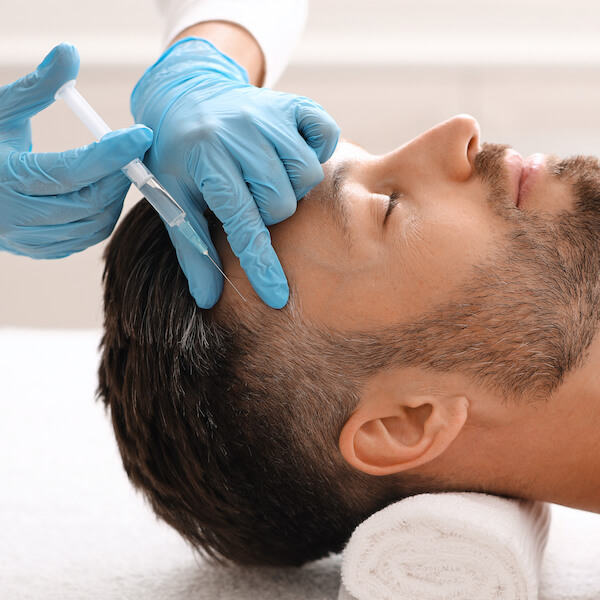
Understanding PRP
Platelet Rich Plasma, as the name suggests, is a concentrated plasma containing a higher number of platelets than what is found in regular blood.
The primary purpose of platelets in the body is to promote wound healing, but they are also a rich source of growth factors. These growth factors play a vital role in cell proliferation, differentiation, and overall tissue regeneration.
The PRP Treatment Process
When considering PRP for hair loss, the procedure begins with drawing a small amount of the patient's own blood. This blood is then placed in a centrifuge, which separates the components of the blood, isolating the platelet rich plasma from other constituents like red and white blood cells. Once isolated, this rich plasma, with a higher concentration of platelets, is then ready for use.
For the actual treatment, the scalp area suffering from hair thinning or hair loss is numbed, and the concentrated PRP is administered through precise prp injections into the scalp, targeting areas with diminished hair density.
Mechanism of Action
At the heart of PRP therapy's success is its interaction with hair follicles. Hair follicles, the structures in the skin filled with tiny blood vessels, are responsible for hair growth. When PRP, abundant in growth factors, is introduced into areas of thinning hair, several processes are triggered:
Stimulation of Dormant Hair Follicles
Growth factors in PRP can potentially awaken dormant hair follicles, transitioning them from the resting phase (telogen) into the active growth phase (anagen).
Strengthening Existing Follicles
PRP therapy is believed to increase hair shaft thickness by improving the nutritive supply to surrounding hair follicles, thereby combating hair thinning.
Enhancing Blood Circulation
The introduction of PRP can amplify blood vessel formation around hair follicles, ensuring that they receive an adequate supply of nutrients and oxygen, crucial for healthy hair growth.
Reducing Inflammation
Chronic inflammation can exacerbate hair loss. The growth factors in PRP have anti-inflammatory properties, which can potentially mitigate hair loss linked to inflammatory conditions.
While the focus remains on the potential of PRP to combat hair loss, it's essential to understand that PRP treatment is just one of several available hair restoration methods.
The role of platelet rich plasma for treating thinning hair and it's efficacy in being able to promote hair regrowth and treat hair loss as well as its suitability can vary depending on individual conditions and requirements.
The Science behind Platelet Rich Plasma Treatment for Hair Growth
For anyone experiencing hair loss, the search for an effective hair loss treatment can be exhaustive. Among the many treatment options available today, Platelet Rich Plasma (PRP) therapy for hair loss has emerged as a potential solution, showing promise in various studies and medical research. Delving deep into the science can offer assurance about its credibility and potential efficacy.
Male Pattern Baldness
Male pattern baldness, or its clinical term, androgenic alopecia, stands as the most prevalent form of hair loss in men across the globe.
Manifesting predominantly as a receding hairline and thinning hair atop the crown, its progression can often lead to the fusion of these balding areas. Ultimately, this creates a distinctive horseshoe pattern of hair remaining around the sides and rear of the scalp.
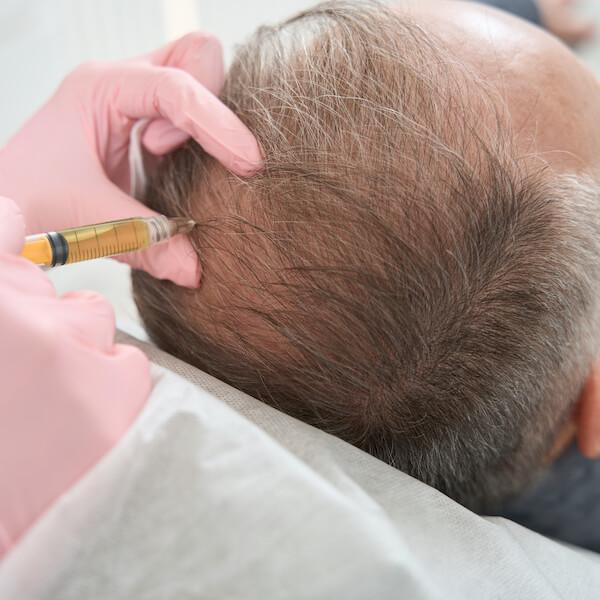
Since ancient times, male pattern baldness has been observed and documented. Historically, it was seen as a sign of wisdom or age, with some cultures even attributing baldness to virility or leadership. However, modern science has allowed us to understand the genetic underpinnings of this condition. Research has shown that androgenic alopecia is primarily a hereditary condition. If a man's father or grandfather experienced baldness, his chances of experiencing it increase.
The main protagonist behind male pattern baldness is a potent derivative of testosterone called dihydrotestosterone (DHT). In men genetically predisposed to male pattern baldness, hair follicles are more sensitive to DHT. This hormone attaches to hair follicles and causes them to shrink, weaken and eventually die.
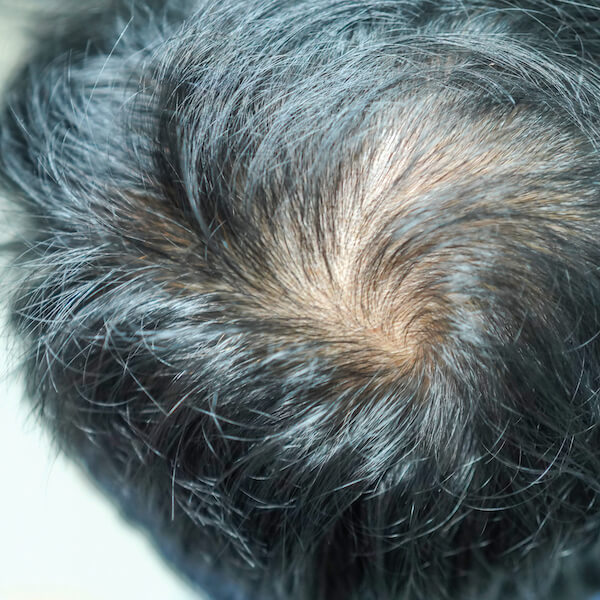
Over time, exposure to DHT alters the hair's growth cycle. Firstly, it shortens the anagen phase (the active growth phase), causing hairs to grow shorter and more fragile. Concurrently, DHT lengthens the telogen phase (the resting phase). This extended gap between the shedding of hairs and the commencement of new growth cycles means fewer hairs are present on the scalp at any given time, exacerbating the appearance of baldness.
Androgenic alopecia can begin as early as a man's late teens, with research indicating that by the age of 35, approximately two-thirds of men will have some degree of hair loss. By the age of 50, about 85% of men experience significant thinning related to male pattern baldness.
Though age plays a pivotal role in the manifestation of androgenic alopecia, genetic predisposition can determine the age of onset, speed, pattern, and severity of hair loss. Some genes that might be involved include those responsible for hair growth, hormone regulation, and inflammation, although more research is still ongoing in this area.
With the myriad of treatments available for male pattern baldness, Platelet Rich Plasma (PRP) treatment is emerging as a beacon of hope for many. The principle behind PRP treatment hinges on its rich content of growth factors, which have shown promise in rejuvenating dormant hair follicles. The infusion of these growth factors into the scalp, through PRP, may lead to hair regrowth in balding areas, increasing hair density, and potentially slowing the progression of hair loss.
Recent studies have illuminated the potential efficacy of PRP treatments. For instance, a 2023 study in the Cureus Journal of Medical Science found that PRP treatment as a hair loss treatment was found to have mild improvement in 48.1% of patients, moderate improvement in 18.5% of patients and 3.7% with excellent improvement. Of note is that all the patients in the study with vertex involvement showed a response to PRP treatment.
Female Pattern Hair Loss
Female pattern hair loss, often referred to as female pattern baldness, manifests differently than its male counterpart. Women typically experience thinning hair on the top and crown of the scalp, often preserving the hairline. While the exact cause of female pattern hair loss isn't entirely understood, it's believed to be related to aging, genetics, and levels of male hormones (androgens) present in women.
Just like in male pattern baldness, the hair follicles in women become more sensitive to androgens and start to shrink. As the hair follicles shrink, the hair's growth cycle is shortened, and the hair becomes thinner and more brittle.
Studies have shown that PRP therapy can be an effective hair loss treatment for women suffering from female pattern hair loss. By delivering concentrated amounts of growth factors to the scalp, PRP for hair loss has demonstrated the potential to stimulate new hair growth and increase the thickness of thinning hair in women.

The Alternatives: Minoxidil, Hair Graft & Hair Transplantation
Efficacy of Minoxidil vs PRP Treatment
Minoxidil is a topical solution primarily used to address hair thinning and pattern hair loss, including conditions such as androgenetic alopecia and female pattern baldness.
Initially introduced as a treatment for hypertension, it was soon discovered that one of its side effects was the stimulation of hair regrowth. On the other hand, platelet-rich plasma (PRP) treatment involves extracting a patient's own blood, separating the platelet-rich plasma from red and white blood cells using centrifugation, and then injecting the PRP into the scalp. PRP injections are believed to stimulate hair regrowth due to the growth factors present in the plasma.
In terms of efficacy, topical minoxidil has been around for longer and has substantial research backing its ability to halt further hair loss and promote new hair growth. However, maintenance treatments are required to sustain its benefits.
On discontinuation, hair shedding can increase. PRP for hair loss, on the other hand, is relatively newer but has shown promising results in enhancing hair density and addressing hair thinning. Unlike minoxidil, PRP treatments utilize the body's own growth factors, thereby reducing the risk of an allergic reaction. That said, PRP treatment may require maintenance treatments, particularly if the underlying cause of hair loss persists.
Follicular Unit Extraction vs Platelet Rich Plasma Therapy
Follicular Unit Extraction (FUE) is a hair transplant technique that involves extracting individual hair grafts from a donor area (typically the back of the head) and implanting them into the recipient area. It's a popular method in hair transplantation due to the absence of a linear scar. The transplanted hair will, after a period of initial shedding, begin to grow as natural hair.
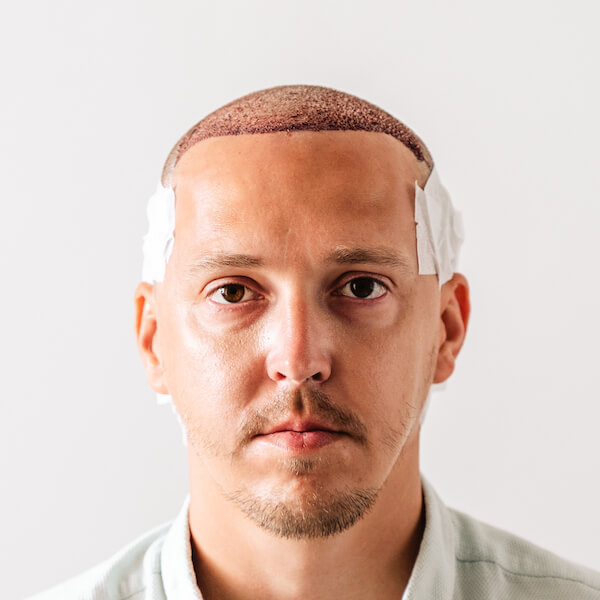
Platelet Rich Plasma (PRP) therapy, meanwhile, doesn't involve hair grafts. Instead, it's a non-surgical procedure that capitalizes on the growth factors in one's own blood to stimulate hair regrowth and reduce hair thinning.
Comparatively, FUE provides a more immediate solution for filling bald patches and has the advantage of relocating existing hair follicles to achieve a denser look. PRP therapy, while effective in stimulating hair regrowth and increasing hair density, might not yield as dramatic results as hair transplantation in individuals with significant balding. However, PRP treatments are less invasive than FUE, with a quicker recovery period.
Both treatments come with their unique advantages. FUE is ideal for individuals seeking to address bald patches or significant hair thinning. It's a more permanent solution, though the success of the transplanted hair depends on the skill of the surgeon and post-surgery care. PRP, on the other hand, is more about hair restoration from the inside out. It's suitable for those experiencing hair thinning or early stages of alopecia areata but might not be as effective for those with advanced baldness.
Frequently Asked Questions about PRP for Hair
Can I use PRP for Hair after a Hair Transplant to help transplanted hair growth?
Yes, PRP (Platelet Rich Plasma) therapy can be used post-hair transplant to potentially expedite the healing process and promote the growth of the transplanted hair. PRP is derived from a patient's own blood, rich in growth factors and proteins that can aid tissue regeneration and enhance blood circulation to the hair follicles. When used after a hair transplant procedure, like Follicular Unit Extraction (FUE), PRP can facilitate quicker recovery, reduce inflammation, and foster a conducive environment for the newly transplanted hair grafts to thrive.
Several hair restoration specialists have recognized the synergistic benefits of combining hair transplant procedures with PRP treatments. The growth factors present in PRP can invigorate dormant hair follicles, promoting increased hair density and possibly ensuring better anchorage of the transplanted hair. Furthermore, PRP can reduce the risk of transplant shock, where transplanted hair might shed initially before regrowing.

